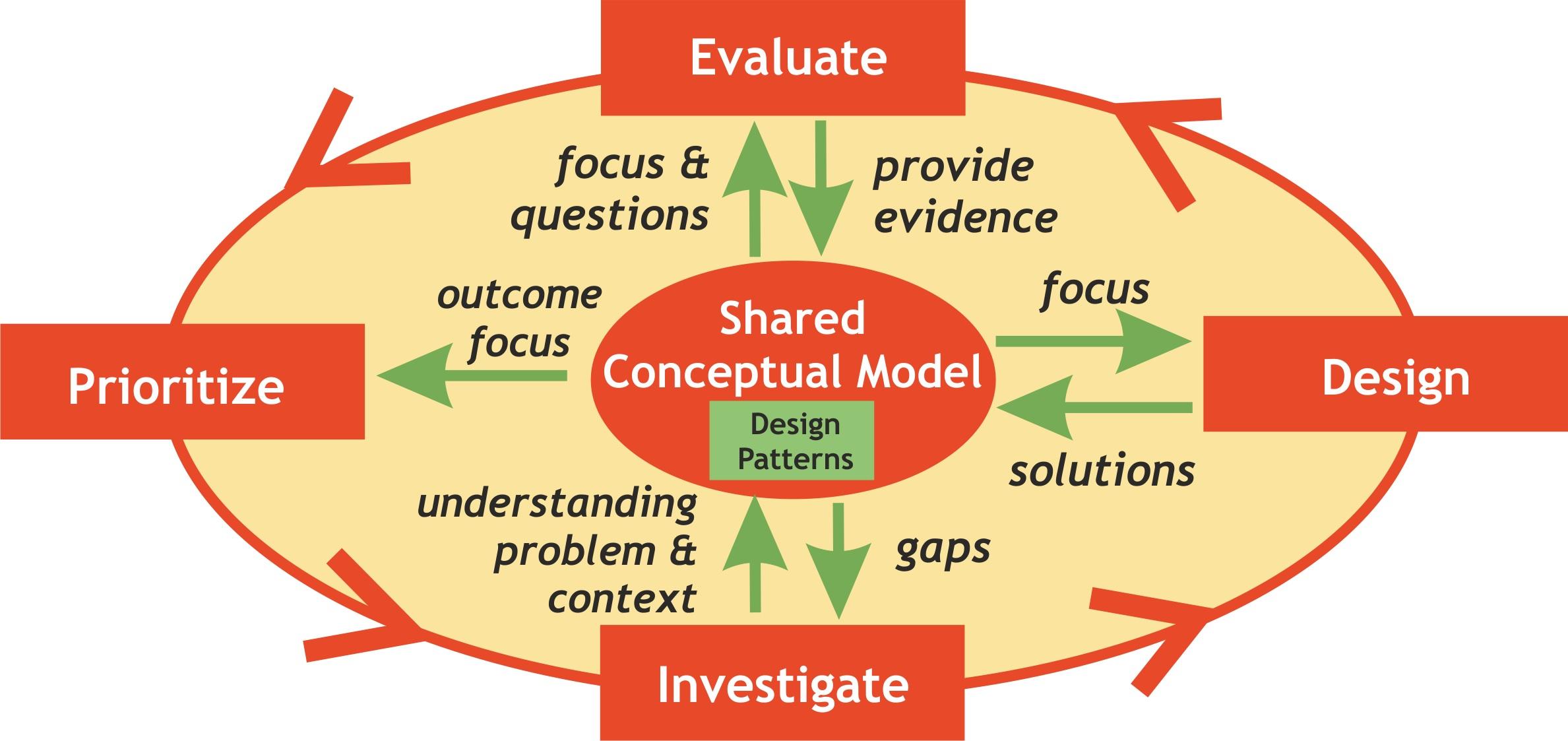Design Based Research
Theoretical Basis
Following [1] understanding of DBR, researchers worked in collaboration with stakeholders to systematically, pragmatically and iteratively generate, analyse and improve the design, its implementation and the underlying theory. In this way, ‘DBR aims at making both practical and scientific contribution’ [2] leading to a theoretically grounded and contextualized design artefact such as a technological mean embedded in a reasonably designed practice. The co-production of new theories, artifacts and practices at the same time is also encouraged by [3], [4], [5], [6], [7], [8], [9], [10], [11], and [12] adopted into our definition and application of design based research.
Process applied in Learning Layers
The underlying research methodology for LAYERS is Design-based research (see interactive figure below). While there have been differences in specific methods and terminology due to different contextual constraints and priorities, all co-design activities have built upon this research approach and gathered experiences that help to evolve the research methodology further in the field of technology-enhanced learning. In this approach, research activities are intertwined with design activities and follow an iterative process model. Design-Based Research is not only interested in the design artefacts, but also in more general insights gained through creating and validating designs, which is represented by the shared conceptual model in the middle (see figure below).
A particular contribution from Learning Layers has been to introduce a Pattern-based approach as a central complement to Design-based Research. Patterns are part of the Shared Conceptual Model that is built along the different iterations , in addition to theory development and design artefacts. Patterns are specifically targeted at representing generalizable outcomes. They can be introduced in early cycles (explore Design» Participatory Patterns Design Process) or at later stages when design artefacts have stabilized; also patterns can start at a higher level of abstraction (such as the meta design patterns) and be then decomposed into more specific patterns.
However it is important to consider that the pattern development is part of the research process and not just a report-like description of an outcome. They have to evolve along-side the research activities as their structure (and the categories expressed in this structure) interacts with the research process:
-
Patterns focus on (innovative) contributions while designs usually consist of more elements that are prerequisites, e.g., for deployment in practice. They therefore help to prioritize design activities in a research project.
-
Patterns capture investigative results as part of better problem and context descriptions, and the difficulties in describing pattern highlight gaps in the current understanding that should be the focus of further empirical analysis. The most difficult part usually is identifying the context characteristics for the class of contexts in which the problem/solution pair is valid.
-
As patterns establish a design language, they give focus to the design activities and capture the solutions, and hence develop the corresponding LAYERS tools.
-
Evaluation, both formative and summative, yield evidence to the problem/solution pairs and considering as a prioritizing factor the selection of the most important evaluation questions.

Integrating patterns into the Design-based Research cycle
The mutual influence of all four areas leads to their parallel development in terms of a coevolution: e.g. if new theoretical and/or domain related insights are gained in the evaluation of a certain prototype, they will lead to the creation of new features in the prototype that potentially provide affordances being in line with the existing practice, change deviating ones and trigger the needed ones.
Examples of application in Learning Layers
The following section contains a list of learning scenarios that illustrates very well the main results of applying DBR in real workplace contexts (i.e. Healthcare and Construction). These results includes: new theories proposed in Layers, examples of co-design interventions, derived Design-patterns, prototypes of tools and the findings obtained from the Evaluation. You can find more detail by selecting the following learning scenarios below:
Further Reading:
-
Layers D2.3 Tools for Networked Scaffolding in Layers Ecosystem. Link: https://drive.google.com/file/d/0B2jesE8OfDgRVGN4bDFHbDJPMzQ/view
-
DBR and work based learning: Bauters, M., Cook, J., Colley, J., Bannan, B., Schmidt, A. & Leinonen, T. (2013b). Towards a Design Research Framework for Designing Support Informal Work-Based Learning. ECTEL-meets-ECSCW Workshop on Collaborative Technologies for Working and Learning 2013, Paphos, Cyprus, pp. 1-5. [10]
-
Community-oriented design science research in the IS community: D. Renzel, R. Klamma, and M. Jarke, “IS Success Awareness in Community-Oriented Design Science Research,” in New Horizons in Design Science: Broadening the Research Agenda, Switzerland, 2015, vol. 9073, pp. 413–420. DOI: 10.1007/978-3-319-18714-3_33 [12]
-
DBR and Mobile learning: Bannan, B., Cook, J. and Pachler, N. (2015) Reconceptualizing design research in the age of mobile learning. Interactive Learning Environments. ISSN 1049-4820 [In Press] Available from: http://eprints.uwe.ac.uk/26204 [13]
Contributing Authors
Patricia Santos, John Cook
References
- F. Wang and M. J. Hannafin, “Design-based research and technology-enhanced learning environments,” Educational technology research and development, vol. 53, no. 4, pp. 5–23, 2005.
- J. Van den Akker, “Principles and methods of development research,” in Design approaches and tools in education and training, Springer, 1999, pp. 1–14.
- S. T. March and G. F. Smith, “Design and natural science research on information technology,” Decision support systems, vol. 15, no. 4, pp. 251–266, 1995.
- M. L. Markus, A. Majchrzak, and L. Gasser, “A design theory for systems that support emergent knowledge processes,” MIS quarterly, pp. 179–212, 2002.
- S. Barab and K. Squire, “Design-based research: Putting a stake in the ground,” The journal of the learning sciences, vol. 13, no. 1, pp. 1–14, 2004.
- G. Goldkuhl, “Design theories in information systems-a need for multi-grounding,” JITTA: Journal of Information Technology Theory and Application, vol. 6, no. 2, p. 59, 2004.
- J. G. Walls, G. R. Widmeyer, and O. A. El Sawy, “Assessing information system design theory in perspective: how useful was our 1992 initial rendition?,” JITTA: Journal of Information Technology Theory and Application, vol. 6, no. 2, p. 43, 2004.
- R. H. Von Alan, S. T. March, J. Park, and S. Ram, “Design science in information systems research,” MIS quarterly, vol. 28, no. 1, pp. 75–105, 2004.
- O. Arazy, N. Kumar, and B. Shapira, “A theory-driven design framework for social recommender systems,” Journal of the Association for Information Systems, vol. 11, no. 9, p. 455, 2010.
- M. Bauters, J. Cook, J. Colley, B. Bannan, A. P. Schmidt, and T. Leinonen, “Towards a Design Research Framework for Designing Support Informal Work-Based Learning.,” in ECTEL-meets-ECSCW, 2013, pp. 1–5.
- V. Svihla, “Advances in design-based research,” Frontline Learning Research, vol. 2, no. 4, pp. 35–45, 2014.
- D. Renzel, R. Klamma, and M. Jarke, “IS success awareness in community-oriented design science research,” in International Conference on Design Science Research in Information Systems, 2015, pp. 413–420.
- B. Bannan, J. Cook, and N. Pachler, “Reconceptualizing design research in the age of mobile learning,” Interactive Learning Environments, pp. 1–16, 2015.
